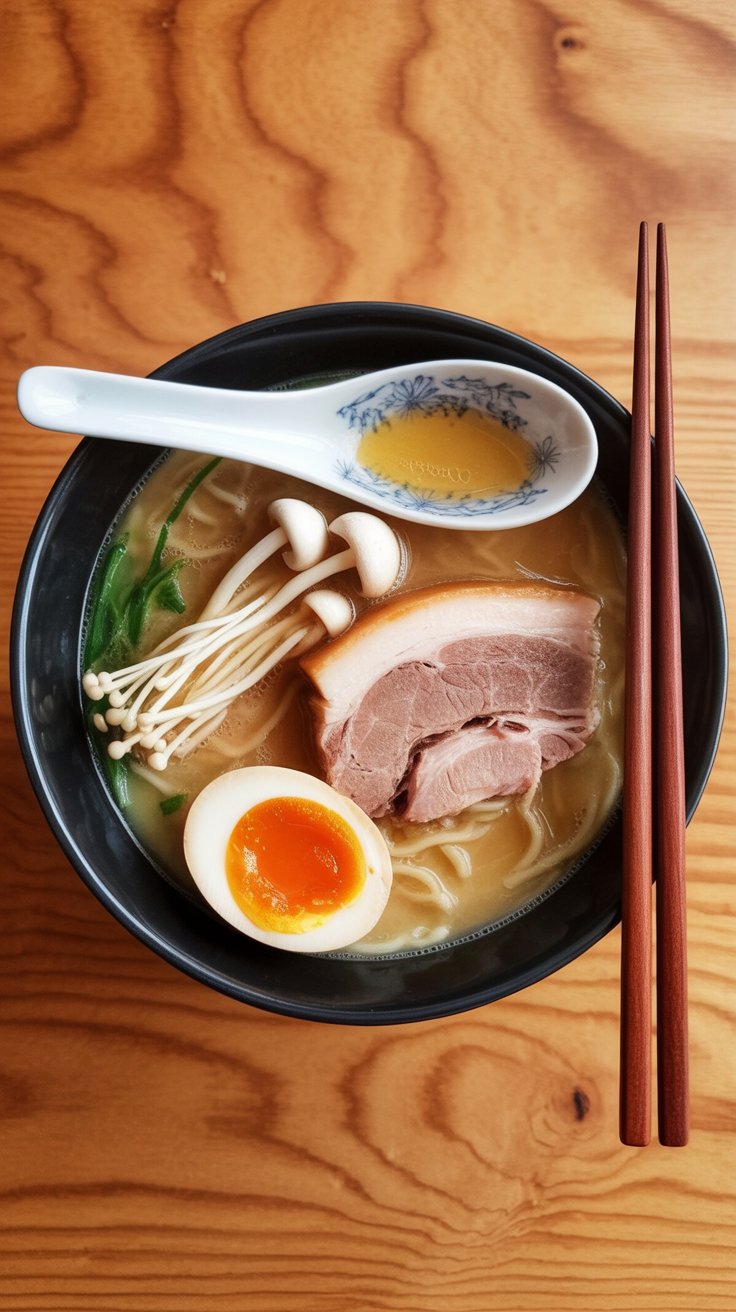There are some dishes you make just for comfort, and then there are dishes that you make because you love every step of the process. Tonkotsu ramen falls into the second category for me. This isn’t a quick dinner. It’s a long, slow, deeply satisfying cooking project — the kind that fills your kitchen with rich, almost intoxicating aromas and gives you something truly special at the end.

I still remember the first time I tried tonkotsu ramen in Japan. The broth was like nothing I’d ever tasted before — creamy, rich, and full of depth. Recreating that at home isn’t exactly easy, but the reward is worth every minute.
Why This Recipe Feels Special
Making tonkotsu ramen from scratch is one of those cooking experiences that teaches patience. It’s not about rushing through steps but about letting each part build into something better. The broth takes hours, the noodles need the right bite, the pork belly melts in your mouth, and that egg — soft, golden, and jammy — ties everything together.
Every time I make this, it turns into a full-day kitchen moment. I’ll start early, put on some music, and let the broth simmer away while I work on other parts. When the ramen finally comes together, the feeling is nothing short of satisfying.
The Heart of the Bowl – The Broth
Tonkotsu broth is what makes this ramen unforgettable. It’s milky, velvety, and incredibly flavorful. This happens when pork bones are simmered for 12 to 18 hours, breaking down into collagen and giving the broth that signature creamy look.
I usually start it the night before if I’m planning to serve it the next day. The key is to let the bones roll in a steady simmer. Not too aggressive, not too light — just a bubbling pot doing its quiet work in the background.
If you make a large batch, it freezes beautifully. That means your next bowl can come together without the long wait.
The Backbone – Noodles
Good noodles make a difference here. Authentic ramen noodles are alkalinated, giving them that firm, springy bite that holds up to the hot broth. Fresh ramen can be tricky to find in some places, but dried Japanese ramen from an Asian market works wonderfully.
A little trick I picked up over the years: if I can’t get proper ramen noodles, I’ll use thin pasta like spaghettini and cook it in baking soda water. It mimics that alkaline texture surprisingly well. It’s not traditional, but it gets the job done when ramen cravings hit hard.
Avoid instant noodles here. They have their place on a lazy night, but for tonkotsu, they just don’t belong.

The Star Topping – Chashu Pork
Chashu pork is what brings that melt-in-your-mouth element to the bowl. I make mine sous vide for 11 hours at 170°F — the result is buttery soft pork belly that just melts. If you don’t use sous vide, braising works well too.
The marinade is simple but flavorful: soy sauce, a little sweetness, and aromatics. Over time, the pork soaks up that deep, savory flavor, and when it hits the hot broth, everything comes together beautifully.
The Soft Egg – Ajitsuke Tamago
The egg in tonkotsu ramen is one of those tiny details that makes a big impact. It’s cooked just enough so that the whites are set and the yolk is soft and silky. Seven minutes is the sweet spot for me. After boiling, I drop them in cold water to stop the cooking, then marinate them in soy sauce for a few hours.
The first time I got this right, it felt like a small victory. That golden yolk spilling slightly into the broth is pure magic.
The Flavor Base – Tare
Tare is what personalizes your ramen. It’s a seasoning base that sits at the bottom of the bowl before the broth goes in. For tonkotsu, I love a soy-bacon tare that gives it a rich umami punch. But you can go as simple as salt or miso.
Once you get comfortable, you’ll start playing with your own versions. Tare is what makes each bowl your own.
Bringing It All Together
Once the broth is ready, the noodles are cooked, and the toppings are prepped, assembling the ramen feels like painting a picture. I start with the tare in the bowl, then pour the hot broth over it. Noodles go in next, followed by slices of chashu pork, the soft egg, and any extras like enoki mushrooms or green onions.
That first slurp after hours of cooking is worth every bit of effort.
Tips That Make a Difference
-
Keep the broth at a steady simmer: Too aggressive and it gets muddy; too gentle and you won’t get that creamy texture.
-
Cook the noodles just before serving: They taste best fresh from the pot.
-
Marinate the eggs early: A few hours make a big difference in flavor.
-
Don’t overload the bowl: Let each component shine.

FAQs
How long does it take to make tonkotsu broth?
Around 12 to 18 hours of simmering gives the broth that rich, creamy consistency.
Can I make the broth ahead of time?
Yes. It freezes well and can be reheated when you’re ready to serve.
What can I use if I can’t find ramen noodles?
Thin pasta like spaghettini cooked in baking soda water works surprisingly well.
Do I need to use sous vide for the pork?
Not at all. Braising pork belly works beautifully if you don’t have a sous vide machine.
Homemade Tonkotsu Ramen

A bowl of tonkotsu ramen is the ultimate expression of comfort — rich, silky pork broth paired with springy noodles, tender chashu pork, and a perfectly jammy egg.
Ingredients
- 8 cups tonkotsu pork broth
- 12 oz dried ramen noodles
- 4 large or extra-large eggs
- 2 to 3 oz enoki mushrooms or your favorite variety
- Thinly sliced green onions, for garnish
Chashu Pork Belly
- 2 lb pork belly, rolled and tied
- ¼ cup soy sauce
- ½ cup sake
- ½ cup mirin
- ¼ cup sugar
- 2 to 3 garlic cloves, left whole
- 2 green onions, coarsely chopped
Soy Bacon Tare
- 2 slices good quality bacon
- ¼ cup soy sauce
- 2 tablespoons mirin
- 2 tablespoons sake
- 4 tablespoons shiro miso
Miso Tare
- ½ cup shiro miso
- ¼ cup sake
- ¼ cup mirin
- Pinch shichimi togarashi (optional)
- 1 to 2 teaspoons kosher salt, to taste
Instructions
- For the chashu pork belly, combine soy sauce, sake, mirin, sugar, garlic, and green onions in a large Ziploc bag. Add the pork belly, remove as much air as possible, and seal. Cook sous vide at 170°F for about 10 to 11 hours. Once done, discard the marinade and allow the pork to cool completely. Slice it into thin, bacon-like pieces before serving.
- For the soy bacon tare, place all ingredients in a small saucepan and let it gently simmer on low heat for about an hour. Add a splash of chicken stock if it gets too thick. Remove the bacon before using.
- For the miso tare, combine the miso, sake, mirin, shichimi togarashi (if using), and salt in a saucepan. Simmer over low heat for about 5 minutes until slightly thickened.
- To make the medium-boiled eggs, bring a pot of water to a rolling boil. Carefully lower the eggs in and boil for 6 minutes 30 seconds for large eggs or 7 minutes 30 seconds for extra-large ones. Chill them immediately in ice water, peel, and slice just before assembling the ramen.
- Cook the ramen noodles in boiling water according to the package directions. In the last minute of cooking, add the mushrooms to the pot to soften them slightly. In a separate skillet, gently sear the chashu pork slices until lightly browned.
- To assemble, place one quarter of the tare in the bottom of each bowl. Ladle in about ½ cup of the tonkotsu broth and stir to combine with the tare. Add the cooked noodles, then pour in about 1½ cups more broth per bowl. Top each serving with chashu pork, half of a jammy egg, softened mushrooms, and a sprinkle of green onions.
Notes
- Either tare works beautifully — use soy bacon tare for a smoky depth or miso tare for a savory richness. If making chashu feels too involved, roasted pork shoulder makes a fantastic substitute.
Nutrition Information
Yield
4Serving Size
1Amount Per Serving Calories 1238Total Fat 64gSaturated Fat 22gTrans Fat 1gUnsaturated Fat 39gCholesterol 382mgSodium 4381mgCarbohydrates 65gFiber 4gSugar 40gProtein 78g
Easy Shrimp Recipes.com, occasionally offers nutritional information for recipes contained on this site. This information is provided as a courtesy and is an estimate only. This information comes from online calculators. Although allchickenrecipes.com attempts to provide accurate nutritional information, these figures are only estimates.
Final Thought
Homemade tonkotsu ramen isn’t just a recipe — it’s a cooking ritual. It takes time, patience, and a little bit of stubbornness, but the reward is a bowl that warms you from the inside out. The broth, the noodles, the pork, the egg — everything builds up to that perfect first spoonful.
It may not be a quick weeknight dinner, but it’s the kind of dish that turns a simple meal into something memorable. Every time I make it, I’m reminded why I love cooking — it’s about creating something with care and enjoying every bit of it.

